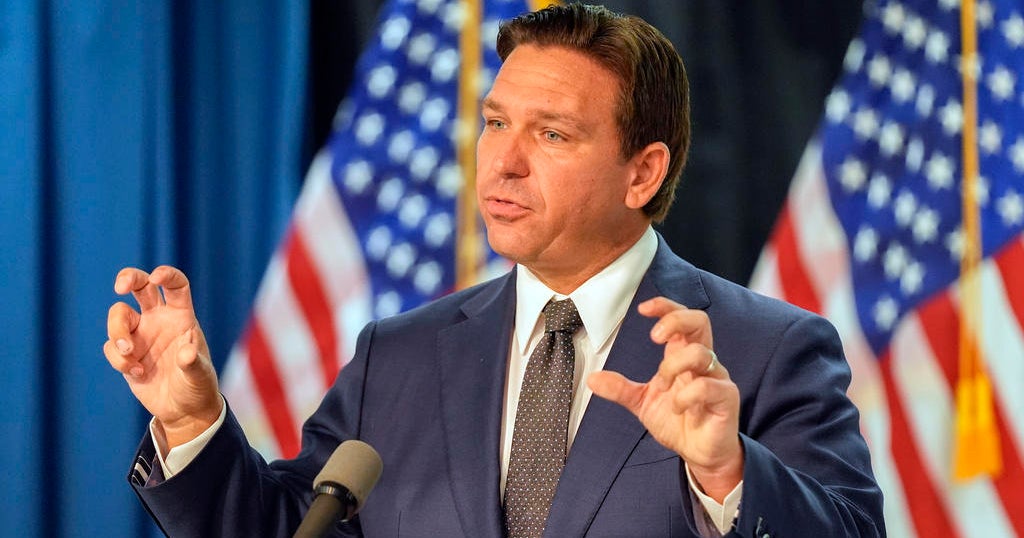Hurricane Irma shifts away from Miami, taking aim at Tampa
MIAMI -- Hurricane Irma hurtled toward Florida with 125 mph winds Saturday on a new projected track that could put the Tampa area -- not Miami -- in the crosshairs. The Tampa area has not taken a direct hit from a major hurricane in nearly a century.
"You need to leave -- not tonight, not in an hour, right now," Gov. Rick Scott warned residents in the evacuation zones ahead of the storm's predicted arrival on Sunday morning.
As of 5 p.m. ET, the powerful Category 3 storm was located about 115 miles southeast of Key West.
For days, the forecast had made it look as if the Miami metropolitan area of 6 million people on Florida's Atlantic coast could get hit head-on with the catastrophic and long-dreaded Big One.
The westward swing in the hurricane's projected path overnight caught many on Florida's Gulf coast off guard. By late morning, few businesses in St. Petersburg and its barrier islands had put plywood or hurricane shutters on their windows, and some locals groused about the change in the forecast.
Donna Tubbs, who lives in a mobile home park in Lakeland, says she's packed her bags but she's not leaving home. "All the families around here are planning to stay," Tubbs told CBS affiliate WTSP-TV in Tampa. She said many in the area are retired nurses who intend on helping with recovery efforts.
Tampa has not been struck by a major hurricane since 1921, when its population was about 10,000, National Hurricane Center spokesman Dennis Feltgen said. Now the area has around 3 million people.
The new course threatened everything from Tampa Bay's bustling twin cities of Tampa and St. Petersburg to Naples' mansion- and yacht-lined canals, Sun City Center's sprawling compound of modest retirement homes, and Sanibel Island's shell-filled beaches.
Forecasters warned of storm surge as high as 15 feet along a swath of southwest Florida and beyond.
"This is going to sneak up on people," said Jamie Rhome, head of the hurricane center's storm surge unit.
With the new forecast, Pinellas County, home to St. Petersburg, ordered 260,000 people to leave, while Georgia scaled back evacuation orders for some coastal residents.
Irma has left more than 20 people dead in its wake across the Caribbean, ravaging such resort islands as St. Martin, St. Barts, St. Thomas, Barbuda and Antigua.
The storm weakened slightly in the morning but was expected to pick up strength again before hitting the Sunshine State.
Meteorologists predicted its center would blow ashore Sunday in the perilously low-lying Florida Keys, then hit southwestern Florida and move north, plowing into the Tampa Bay area. Though the center is expected to miss Miami, the metro area will still get pounded with life-threatening hurricane winds, Feltgen said.
On Saturday morning, the state was already beginning to feel Irma's muscle. Nearly 30,000 people had lost power, mostly in and around Miami and Fort Lauderdale, as the wind began gusting.
In Key West, 60-year-old Carol Walterson Stroud sought refuge in a senior center with her husband, granddaughter and dog. The streets were nearly empty, shops were boarded up and the wind started to blow.
"Tonight, I'm sweating," she said. "Tonight, I'm scared to death."
In one of the biggest evacuations ever ordered in the U.S., about 6.4 million people in Florida - more than one-quarter of the state's population - were warned to leave. Gas shortages and gridlock plagued the evacuations. Parts of interstates 75 and 95 north were bumper-to-bumper.
Some 54,000 people crowded 320 shelters across Florida. At Germain Arena not far from Fort Myers, on Florida's southwestern corner, thousands waited in a snaking line for hours to gain a spot in the hockey venue-turned-shelter.
"We'll never get in," Jamilla Bartley lamented as she stood in the parking lot.
The governor activated all 7,000 members of the Florida National Guard, and 30,000 guardsmen from elsewhere were on standby.
Major tourist attractions, including Walt Disney World, Universal Studios and SeaWorld, all prepared to close Saturday. The Miami and Fort Lauderdale airports shut down, and those in Orlando and Tampa planned to do the same later in the day.
With winds that peaked at 185 mph, Irma was once the most powerful hurricane ever recorded in the open Atlantic. Given its mammoth size and strength and its projected course, it could still prove one of the most devastating hurricanes ever to hit Florida and inflict damage on a scale not seen here in 25 years.
It could also test the Federal Emergency Management Agency's ability to handle two crises at the same time. FEMA is still dealing with aftermath of catastrophic Hurricane Harvey in the Houston area.
Ray Scarborough and girlfriend Leah Etmanczyk left their home in Big Pine Key and fled north with her parents and three big dogs to stay with relatives in Orlando. Scarborough was 12 when Hurricane Andrew hit in 1992 and remembers lying on the floor in a hall as the storm nearly ripped the roof off his house.
"They said this one is going to be bigger than Andrew. When they told me that, that's all I needed to hear," said Scarborough, now a 37-year-old boat captain. "That one tore everything apart."
Andrew razed Miami's suburbs with winds topping 165 mph, damaging or blowing apart over 125,000 homes. The damage in Florida totaled $26 billion, and at least 40 people died.




